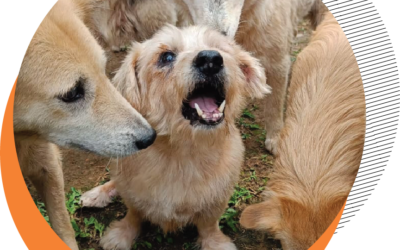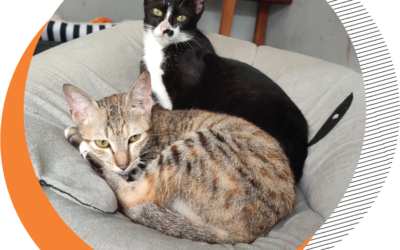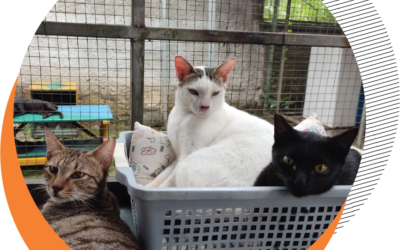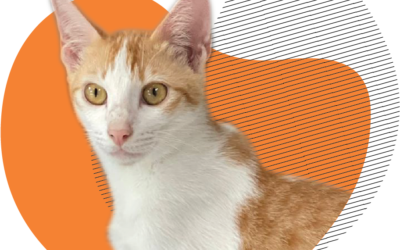
Tips for Feeding Orphaned Kittens
By: Maryam Smeer
The best condition for a baby kitten is in the care of its mother. However, not all baby kittens are that lucky. There are some conditions where the mother is absent or unable to care for her babies directly.
Baby kittens are very fragile. The chances of a baby kitten dying are quite high. Even if Pawrents take the best care of them, kittens are still fragile. Sometimes 1 in 4 baby kittens survive only the first week.
Despite this condition, Pawrents still need to pay attention to the kitten. Especially if the kitten is not in the care of its mother. Providing the best care is still something we must do. But if it turns out that the kitten died, Pawrents should not blame themselves. Even though the loss is hard.
Image 1. JAAN Domestic Shelter

This time, Animalwelfare.id provides some care tips for orphaned kittens. The following tips are for babies aged 0-3 weeks:
1. Regular Feeding
At this age, kittens need to be fed every 2-4 hours. At this age, baby kittens only need a diet of milk. This food is given using a bottle. If the kitten does not want to drink milk, Pawrents can wait until the next feeding time to try again. If the kitten does not take milk within two consecutive feedings, contact your veterinarian.
2. Formula Milk
Kitten Milk Replacement (KMR) formula will be given to all kittens that require bottle feeding. Pawrents can follow the instructions given on the KMR in serving it. Pay attention when dissolving the formula. The division is one part formula to two parts water. For the first few feedings, Pawrents can increase the amount of water slightly to dilute the formula. This is to help reduce indigestion.
Read Also : The Kitten Bottle Feeding Guide
3. Formula Storage
Reconstituted formula that has not been warmed up can be stored in the refrigerator for up to 24 hours. Powdered formula that has not been reconstituted should also be stored in the refrigerator after opening. Do not store powdered milk for more than 3 months.
4. Serving Amount of Milk
Prepare only enough formula milk, Pawrents. Dissolve the formula only in the amount needed. Baby kittens usually require about 4mL per 100g of body weight at each feeding. This means kittens need a total of about 30mL over a 24-hour period.
5. Watch Milk Temperature
Formula should be warmed before serving. This can be done by placing the cold KMR bottle upright into a cup of hot water. Check the temperature of the formula on the inside of your wrist before feeding each kitten. The temperature should be warm to the touch but not hot.
6. Deliver Safely
Once the milk is ready to serve, feed it safely. Pawrents should test the bottle teat and make sure the formula is dripping slowly. Kittens choke very easily (inhaling liquid into the lungs).
If formula comes out of the kitten’s nose, stop feeding immediately. If this happens, stop feeding until the kitten’s lung fluid has cleared completely. This is usually signaled by sneezing. If you hear crackling or popping sounds when your kitten breathes, or if you suspect your kitten has inhaled formula, contact your local Veterinarian immediately.
Read Also : Healthy Cats = Proper Diet
7. Ensure Kittens are Warm
When FeedingMake sure the kitten is not cold before feeding so that the food can be digested properly. Prepare the kitten for feeding by placing it on its stomach or wrapping it in a small towel like a taco if it is fussy.
8. Kitten’s position when fed
If wrapped in a towel, make sure the kitten can still squeeze with its front paws outside the towel and not in a supine position, which can cause choking. When lying on her stomach, make sure she is in an upright position with her head slightly tilted up and neck straightened (like she is nursing from mom). Support the lower body with the palms of your hands and hold the head
steady with your thumb and forefinger. Never express milk by
squeezing the bottle as this may cause choking/aspiration.
Bottle feeding takes practice and patience to master.
9. Don’t overfeed
Make sure Pawrents do not overfeed the kitten. Pawrents can check the fullness of its stomach while feeding. After bottle feeding, gently burp the kitten by placing it on its stomach with the palm of one hand and patting its back several times with the other hand.This will allow the swallowed air to escape, but you will not hear the kitten “burp”.
10. Clean the feeding bottle
Clean the feeding bottle with soap and water immediately after feeding. This is to avoid micro-organisms that can interfere with the baby kitten’s digestion.
11. Urination Stimulation
In kittens less than 3 weeks old, the urinary reflex still needs to be stimulated. Usually this is done by the baby’s mother. But for orphaned babies, Pawrents need to do it. Please note, the micturition reflex usually starts when the mother cat licks the kitten’s anogenital area. Therefore, caregivers should mimic this by gently massaging the kitten’s ano-genital area using a warm damp cloth or cotton ball. This should be done after every feeding, and each kitten should urinate and defecate at least once a day.
This time, Animalwelfare.id provides some care tips for orphaned kittens. The following tips are for babies aged 0-3 weeks:
1. Regular Feeding
At this age, kittens need to be fed every 2-4 hours. At this age, baby kittens only need a diet of milk. This food is given using a bottle. If the kitten does not want to drink milk, Pawrents can wait until the next feeding time to try again. If the kitten does not take milk within two consecutive feedings, contact your veterinarian.
2. Formula Milk
Kitten Milk Replacement (KMR) formula will be given to all kittens that require bottle feeding. Pawrents can follow the instructions given on the KMR in serving it. Pay attention when dissolving the formula. The division is one part formula to two parts water. For the first few feedings, Pawrents can increase the amount of water slightly to dilute the formula. This is to help reduce indigestion.
Read Also : The Kitten Bottle Feeding Guide
3. Formula Storage
Reconstituted formula that has not been warmed up can be stored in the refrigerator for up to 24 hours. Powdered formula that has not been reconstituted should also be stored in the refrigerator after opening. Do not store powdered milk for more than 3 months.
4. Serving Amount of Milk
Prepare only enough formula milk, Pawrents. Dissolve the formula only in the amount needed. Baby kittens usually require about 4mL per 100g of body weight at each feeding. This means kittens need a total of about 30mL over a 24-hour period.
5. Watch Milk Temperature
Formula should be warmed before serving. This can be done by placing the cold KMR bottle upright into a cup of hot water. Check the temperature of the formula on the inside of your wrist before feeding each kitten. The temperature should be warm to the touch but not hot.
6. Deliver Safely
Once the milk is ready to serve, feed it safely. Pawrents should test the bottle teat and make sure the formula is dripping slowly. Kittens choke very easily (inhaling liquid into the lungs).
If formula comes out of the kitten’s nose, stop feeding immediately. If this happens, stop feeding until the kitten’s lung fluid has cleared completely. This is usually signaled by sneezing. If you hear crackling or popping sounds when your kitten breathes, or if you suspect your kitten has inhaled formula, contact your local Veterinarian immediately.
Read Also : Healthy Cats = Proper Diet
7. Ensure Kittens are Warm
When FeedingMake sure the kitten is not cold before feeding so that the food can be digested properly. Prepare the kitten for feeding by placing it on its stomach or wrapping it in a small towel like a taco if it is fussy.
8. Kitten’s position when fed
If wrapped in a towel, make sure the kitten can still squeeze with its front paws outside the towel and not in a supine position, which can cause choking. When lying on her stomach, make sure she is in an upright position with her head slightly tilted up and neck straightened (like she is nursing from mom). Support the lower body with the palms of your hands and hold the head
steady with your thumb and forefinger. Never express milk by
squeezing the bottle as this may cause choking/aspiration.
Bottle feeding takes practice and patience to master.
9. Don’t overfeed
Make sure Pawrents do not overfeed the kitten. Pawrents can check the fullness of its stomach while feeding. After bottle feeding, gently burp the kitten by placing it on its stomach with the palm of one hand and patting its back several times with the other hand.This will allow the swallowed air to escape, but you will not hear the kitten “burp”.
10. Clean the feeding bottle
Clean the feeding bottle with soap and water immediately after feeding. This is to avoid micro-organisms that can interfere with the baby kitten’s digestion.
11. Urination Stimulation
In kittens less than 3 weeks old, the urinary reflex still needs to be stimulated. Usually this is done by the baby’s mother. But for orphaned babies, Pawrents need to do it. Please note, the micturition reflex usually starts when the mother cat licks the kitten’s anogenital area. Therefore, caregivers should mimic this by gently massaging the kitten’s ano-genital area using a warm damp cloth or cotton ball. This should be done after every feeding, and each kitten should urinate and defecate at least once a day.
Those are some tips on parenting an orphaned baby kitten. If there is any confusion or problems in parenting, don’t hesitate to contact and consult your nearest Veterinarian…
Source :
ASPCA Pro, Feline Foster Care Guide,
https://www.aspcapro.org/sites/default/files/aspcapro-feline-foster-care-guide.pdf
Related Post :
Canine Body Language
Canine Body Language While your dog cannot speak as you do, she does relay her feelings and emotions through a series of body postures, gestures and vocalizations. Her body language can be subtle and wide-ranging, but with a little practice you can learn and...
Healthy Cats = Proper Diet
Healthy Cats =Proper Diet Fresh, clean drinking water is a constant requirement for cats. For cats to maintain their health and fitness, they require a balanced diet that includes foods that are exclusively found in meat-based products. Considering that cats are real...
What is Animal Hoarding ?
What isAnimal Hoarding ? Animal hoarding is a complicated problem where someone keeps more animals than they can afford, according to the American Society for the Prevention of Cruelty to Animals (ASPCA). The complexity of this situation stems from the fact that it...
Why Dogs Bark
Why Dogs Bark Dogs utilise their voice (barking) and body language (wagging their tail, for example) to communicate with humans, other dogs, and other animals when they can't speak. For dogs, barking is a typical behaviour. The majority of normal, healthy dogs bark....
Things you need to know about your cat’s natural behavior
Things you need to knowabout your cat’s natural behaviorCat’s natural behavior is related to age, personality and past experience. Cats really love to play, both with their humans or toys. Playing and moving around is really important for their physical and mental...
Pets as property in Animal Welfare
Pets as propertyin Animal WelfareCitayam Fashion Week in Jakarta is now booming and attracts people’s attention, especially those with a passion for the modeling world. This weekly event shows street fashion a la Harajuku in Japan which attracts people both locally...





